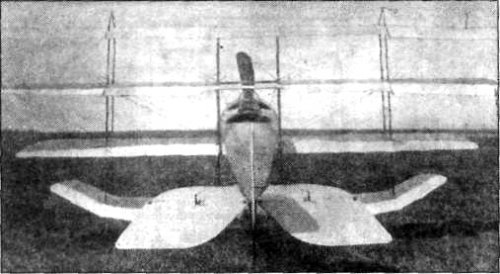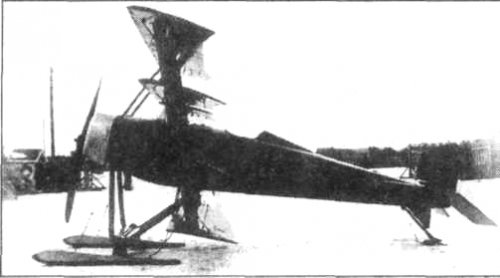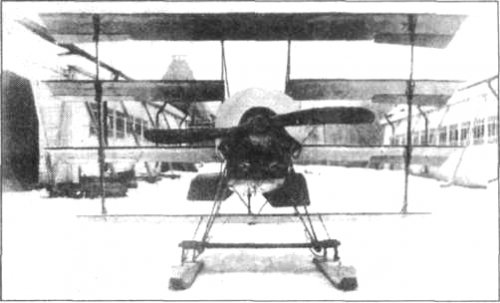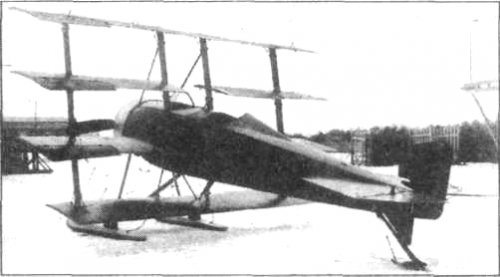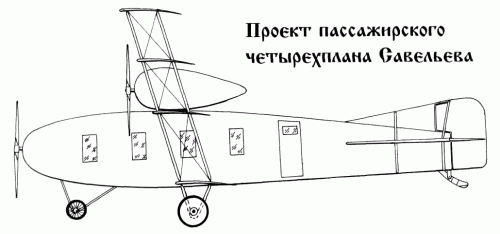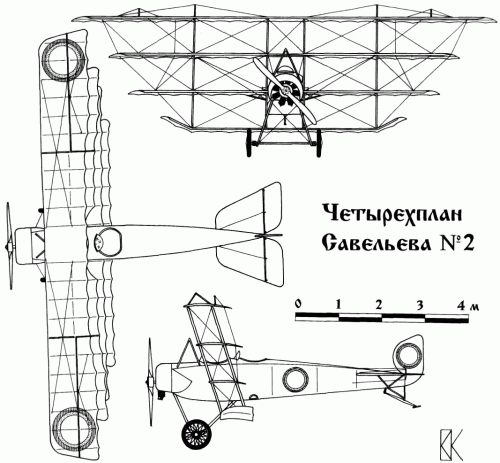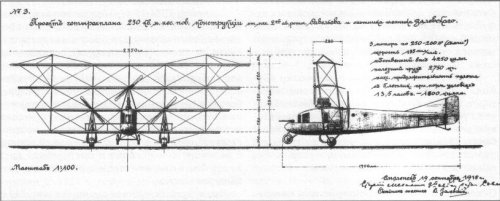- Joined
- 25 June 2009
- Messages
- 13,771
- Reaction score
- 3,043
Until the early 1920s, aircraft development was based mainly on the intuition of designers. As for aerodynamics, this science was in its infancy. Suffice it to say that the concept of inductive resistance was not known at that time, which led to the emergence of "flying monsters" with three, four and even five wings. It was believed that the more wings, the higher the load ratio of aircraft and, accordingly, the faster and farther it would fly, while possessing increased and excellent maneuverability. The appearance of the theory of induced drag, despite the "opposition" of the multiplane proponents, quickly put an end to the concept.
In Russia, the outstanding representative of this trend in aviation industry was Vladimir Fedorovich Saveliev. In 1916, as chief engineer of the 2nd fleet, and together with technician Wladyslaw Zalewski, he built in Smolensk a scout quadruplane with box wings. To be really accurate, the aircraft ought to be considered as a quintuplane, as the second plane from the top consisted of two separate wings. This was done apparently to improve the pilot's forward and upward visibility.
The first machine, designated "Aeroplane N°1" by the company, was a copy of the French Morane F monoplane with its diminutive 80 hp rotary engines, built in April 1916. It was test-flown by experienced military pilot V. A. Jungmeister. The main purpose of the quadruplane, wrote Saveliev, "was to find out the possibility of construction of this type of cargo airplanes capable of flying at a speed of 147 km/h and a distance of 1000 km, carrying 25 people or 1,875 kg of cargo." It is unknown why the author has such a precise figure as 147 km/h, but it is safe to say that this figure was unlikely.
Compared with the Morane F of 1913, "Aeroplane N°1" was 100 kg heavier, but the unit load on the wing fell from 32.8 to 25 kg/sq.m. With the same engines (developing 76 hp in flight), maximum speed at sea level fell by only 3 km/h. How reliable this data is today is difficult to judge, as such figures were often visual estimations. However, this is what was noted in period documents such as the "Report on test results...", presented before a June 8, 1916 commission which included notably Lieutenant Pigeon and Captain Frank Ellis.
But before proceeding with the development of heavier machines, Savelyev got his "Aeroplane N°2" ready for testing, an upgrade on his first brainchild with the more powerful "Gnome Monosoupape" engine. On this occasion, the commander of the 4th Aviation Battalion Colonel Jungmeister wrote on May 4, 1917: « With the permission of the Air Ministry and at the request of the chief engineer (...) I have begun testing Savelyev's Aeroplane N°2. However it was not possible to complete the test because of the poor performance of the Monosoupape engine. The test flight revealed the exceptionally good flying qualities of said aircraft (...) the plane is easily steered and will let itself be flown at non-typical turns and different angles as with Nieuport's "Bébé" aircraft. The plane easily gains height at normal engine regime, and quickly takes off from the ground. Flight speed was determined by observation, and compared with other aircraft may be considered between 130 to 140 km/h — surpassing the Renault Parasol or the second rate Nieuport "Bébé" Type XI.
Aircraft landing can be performed at very low speed (...) In flight, the airplane is pleasant, light and extremely sensitive, responding perfectly to the pilot's maneuvers (...) Such a type of airplane certainly deserves serious consideration, there is no doubt that with an engine developing at least 225 hp (Renault), it will provide combat units with a very capable military aircraft that could be used both for combat and bombing. »
It can therefore be concluded that Savelyev's design fully met the requirements of the time. This is confirmed by authoritative sources. Aviation historian P. D. Duz, who wrote that Aeroplane N°2 was fitted with two machine guns to shoot forward and one to the rear. As such, the aircraft was taken into active service in the 4th Squadron, which would not have happened if the machine had been useless.
In his endeavors, the designer was supported by A. P. Van der Fleet, a Professor of St. Petersburg's Polytechnic Institute, who noted that « ... experience over the Savelyev quadruplane showed that the practical applicability of multiplane system offers hope for successful design of similar devices. " Scholars believe that it would be "very useful for the future promotion of aviation building multiplane devices and considers necessary to place an order with one of the largest airplane factories (...) for three of Savelyev's proposed machines. » Multiplanes, of course, were also designed and flown outside Russia. According to foreign press reports, one of the most successful such designs was the F.K. 10 quadruplane scout of the English company Armstrong Whitworth, built in a few dozen examples and powered by 110 or 130 hp Clerget rotating engines.
A British aviation magazine published an article in the mid-1990s by Polish historian Jerzy Zinc, in which the author attributed the creation of Savelyev's machines to his technician Zalewski, a Pole who lived later in London. Without taking sides in this debate, we can note that in all known archival documents on the subject we find only reference to the "Saveliev quadruplane" not the "Zalewski quadruplane" According to information given in the article, in the Fall of 1916 Aeroplane N°2 apparently took part in combat with the 4th Squadron in Baranovichi. In one of the reconnaissance flights it crashed due to engine failure and was not restored. It also speaks of the beginning of construction in Kiev of the next aircraft with the Renault engine, but the revolution and the subsequent occupation of Ukraine by German troops prevented completion of work.
Meanwhile, the October Revolution of 1917 came in the way of many projects. Savelyev joined the White movement and was at first in Kolchak's army. But he soon joined the Red Army, giving it nearly three years of his life. Savelyev's communications with Kolchak were carefully concealed, but in 1930 the Bolsheviks found out about it. As part of a "cleansing" effort, Savelyev, who was then head of the weapons department at Plant number 39, was found to have "had relationships with sabotaging elements" and was requested to be dismissed and sent to "re-education"...
But let's not go too fast forward. Three years after the revolution Savelyev proposed a heavy passenger quadruplane project. Six months later, the head of Glavvozdu-hoflota, K. V. Akasha (a military pilot and mechanical engineer), wrote: « Savelyev is known for his work in the field of aviation and has built and tested multiplane aircraft designs that were successful on tests (...) successful resolution of the issue of construction of heavy aircraft is based on the principle of multiplane aircraft, (...). Savelyev was asked to design and build (...) an "airship" with a capacity for 25 people. » In late December, Savelyev issued instructions to begin the design and construction of the "airship" with three 220 hp Renault engines at railway factory number 16. However, the plane remained on paper. There seem to have been two reasons for this: First of all, the failure of the Comte triplane, which began flight tests in 1922, and, as already noted, the development of the theory of induced drag, which explained the lack of promise of multiplane designs.
In 1923 Savelyev still managed to build a similarly patterned tandem scout with a 120 hp Rhône engine, very similar to Aeroplane N°2. But in spite of the similarities, the latter had the worst maneuverability ever for a quadruplane and was heavy to maneuver. Its maximum speed did not exceed 164 km/h. Testing of the first airplanes had shown that high maneuverability was obtained exclusively by low specific load on the wings - 25 to 27.5 kg/sq.m. In the 1923 scout, however, this parameter increased to 38.7 kg/m2, which worsened both maneuverability and handling. This marked the end of multiplane designs (except biplanes) not only in Russia but also abroad.
Freely adapted by Stéphane Beaumort from "Polyplane Savelyeva", an article published in Krylia Rodine, July 1997.
In Russia, the outstanding representative of this trend in aviation industry was Vladimir Fedorovich Saveliev. In 1916, as chief engineer of the 2nd fleet, and together with technician Wladyslaw Zalewski, he built in Smolensk a scout quadruplane with box wings. To be really accurate, the aircraft ought to be considered as a quintuplane, as the second plane from the top consisted of two separate wings. This was done apparently to improve the pilot's forward and upward visibility.
The first machine, designated "Aeroplane N°1" by the company, was a copy of the French Morane F monoplane with its diminutive 80 hp rotary engines, built in April 1916. It was test-flown by experienced military pilot V. A. Jungmeister. The main purpose of the quadruplane, wrote Saveliev, "was to find out the possibility of construction of this type of cargo airplanes capable of flying at a speed of 147 km/h and a distance of 1000 km, carrying 25 people or 1,875 kg of cargo." It is unknown why the author has such a precise figure as 147 km/h, but it is safe to say that this figure was unlikely.
Compared with the Morane F of 1913, "Aeroplane N°1" was 100 kg heavier, but the unit load on the wing fell from 32.8 to 25 kg/sq.m. With the same engines (developing 76 hp in flight), maximum speed at sea level fell by only 3 km/h. How reliable this data is today is difficult to judge, as such figures were often visual estimations. However, this is what was noted in period documents such as the "Report on test results...", presented before a June 8, 1916 commission which included notably Lieutenant Pigeon and Captain Frank Ellis.
But before proceeding with the development of heavier machines, Savelyev got his "Aeroplane N°2" ready for testing, an upgrade on his first brainchild with the more powerful "Gnome Monosoupape" engine. On this occasion, the commander of the 4th Aviation Battalion Colonel Jungmeister wrote on May 4, 1917: « With the permission of the Air Ministry and at the request of the chief engineer (...) I have begun testing Savelyev's Aeroplane N°2. However it was not possible to complete the test because of the poor performance of the Monosoupape engine. The test flight revealed the exceptionally good flying qualities of said aircraft (...) the plane is easily steered and will let itself be flown at non-typical turns and different angles as with Nieuport's "Bébé" aircraft. The plane easily gains height at normal engine regime, and quickly takes off from the ground. Flight speed was determined by observation, and compared with other aircraft may be considered between 130 to 140 km/h — surpassing the Renault Parasol or the second rate Nieuport "Bébé" Type XI.
Aircraft landing can be performed at very low speed (...) In flight, the airplane is pleasant, light and extremely sensitive, responding perfectly to the pilot's maneuvers (...) Such a type of airplane certainly deserves serious consideration, there is no doubt that with an engine developing at least 225 hp (Renault), it will provide combat units with a very capable military aircraft that could be used both for combat and bombing. »
It can therefore be concluded that Savelyev's design fully met the requirements of the time. This is confirmed by authoritative sources. Aviation historian P. D. Duz, who wrote that Aeroplane N°2 was fitted with two machine guns to shoot forward and one to the rear. As such, the aircraft was taken into active service in the 4th Squadron, which would not have happened if the machine had been useless.
In his endeavors, the designer was supported by A. P. Van der Fleet, a Professor of St. Petersburg's Polytechnic Institute, who noted that « ... experience over the Savelyev quadruplane showed that the practical applicability of multiplane system offers hope for successful design of similar devices. " Scholars believe that it would be "very useful for the future promotion of aviation building multiplane devices and considers necessary to place an order with one of the largest airplane factories (...) for three of Savelyev's proposed machines. » Multiplanes, of course, were also designed and flown outside Russia. According to foreign press reports, one of the most successful such designs was the F.K. 10 quadruplane scout of the English company Armstrong Whitworth, built in a few dozen examples and powered by 110 or 130 hp Clerget rotating engines.
A British aviation magazine published an article in the mid-1990s by Polish historian Jerzy Zinc, in which the author attributed the creation of Savelyev's machines to his technician Zalewski, a Pole who lived later in London. Without taking sides in this debate, we can note that in all known archival documents on the subject we find only reference to the "Saveliev quadruplane" not the "Zalewski quadruplane" According to information given in the article, in the Fall of 1916 Aeroplane N°2 apparently took part in combat with the 4th Squadron in Baranovichi. In one of the reconnaissance flights it crashed due to engine failure and was not restored. It also speaks of the beginning of construction in Kiev of the next aircraft with the Renault engine, but the revolution and the subsequent occupation of Ukraine by German troops prevented completion of work.
Meanwhile, the October Revolution of 1917 came in the way of many projects. Savelyev joined the White movement and was at first in Kolchak's army. But he soon joined the Red Army, giving it nearly three years of his life. Savelyev's communications with Kolchak were carefully concealed, but in 1930 the Bolsheviks found out about it. As part of a "cleansing" effort, Savelyev, who was then head of the weapons department at Plant number 39, was found to have "had relationships with sabotaging elements" and was requested to be dismissed and sent to "re-education"...
But let's not go too fast forward. Three years after the revolution Savelyev proposed a heavy passenger quadruplane project. Six months later, the head of Glavvozdu-hoflota, K. V. Akasha (a military pilot and mechanical engineer), wrote: « Savelyev is known for his work in the field of aviation and has built and tested multiplane aircraft designs that were successful on tests (...) successful resolution of the issue of construction of heavy aircraft is based on the principle of multiplane aircraft, (...). Savelyev was asked to design and build (...) an "airship" with a capacity for 25 people. » In late December, Savelyev issued instructions to begin the design and construction of the "airship" with three 220 hp Renault engines at railway factory number 16. However, the plane remained on paper. There seem to have been two reasons for this: First of all, the failure of the Comte triplane, which began flight tests in 1922, and, as already noted, the development of the theory of induced drag, which explained the lack of promise of multiplane designs.
In 1923 Savelyev still managed to build a similarly patterned tandem scout with a 120 hp Rhône engine, very similar to Aeroplane N°2. But in spite of the similarities, the latter had the worst maneuverability ever for a quadruplane and was heavy to maneuver. Its maximum speed did not exceed 164 km/h. Testing of the first airplanes had shown that high maneuverability was obtained exclusively by low specific load on the wings - 25 to 27.5 kg/sq.m. In the 1923 scout, however, this parameter increased to 38.7 kg/m2, which worsened both maneuverability and handling. This marked the end of multiplane designs (except biplanes) not only in Russia but also abroad.
Freely adapted by Stéphane Beaumort from "Polyplane Savelyeva", an article published in Krylia Rodine, July 1997.

